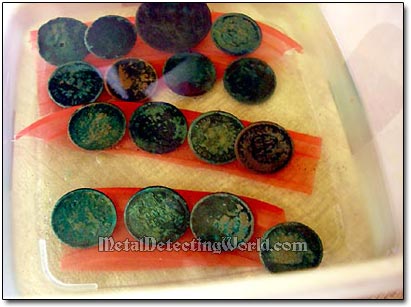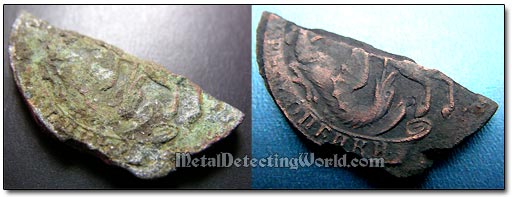Cleaning and Preservation of Coins - A Complete Guide, page 6
MECHANICAL CLEANING of COINS: Soak Coins Before Cleaning, Clean Coins by Frozen Water Expansion
NOTE: Coins should never be worked on with metallic objects such as knives or needles, because this will leave irreparable scratch traces.
1) How To Soak Coins Before Cleaning
Soaking of the newly dug coins can be done either in warm soapy water or in oils such as Olive Oil, Mineral Oil and Motor WD-40 Oil.
A. Soaking in warm water with soap or detergent helps loose and lift the dirt without doing anything to a coin itself, provided the water does not have any dissolved impurities, for instance, atmospheric carbon, in it.
Sometimes hot water and soap do a better job in lifting harden clay and hard-dried mud than olive oil (described below). After two days of soaking, the remains of deposits in small places on the coin's surface can be gently picked and removed with a toothpick or a bamboo skewer (see details on page 7). If the deposits are really hard, soak the coin again, and for a longer while.
B. Soaking in Olive Oil is an effective method for loosening the dirt, but, if the coin is left in for a long time, a slight chemical attack on coin metal may occur due to the presence of fatty acids and traces of sulfur compounds in olive oil.
The coins should not be laid flat on the bottom. For example, they should be placed on the improvised "trays" - plastic strips cut out of a food container's cover, which have high edge. Thus, both sides of each coin are exposed to the oil.
Soaking Coins in Olive Oil

Degreasing with Acetone, which is not ion-forming solvent, must follow.
C. Soaking in Mineral Oil is a more safe method because mineral oil does not have fatty acids and, therefore cannot attack the coin metal, no matter how long the coin is soaked. Degreasing with Acetone, or Ethylene Chloride or Naphtha must follow, long enough to get all oil molecules out of any crevices and pores present in the surface of dug coin.
The following photo depicts a dug fragment of the 18th century coin before it was cleaned and after it was soaked in mineral oil first, then immersed into Ammonia bath and patinated after that.

D. Soaking in WD-40 is very effective but not for a long while. WD-40 should not be left on the coin's surface because the oil will gum up and harden over time, thus making it difficult to remove. Degrease the coin with Acetone.
2) How To Clean Coins by Frozen Water Expansion
This method effectively works on coins that have hard deposits of dirt on their surfaces. This cleaning technique is simple and consists of only two steps:
1) Place a coin in distilled water and soak it for a while so that the water molecules would have enough time to penetrate the dirt and, if possible, other deposits on the coin's surface. Some dirt may break off during soaking, so you just toothbrush it off the coin.
2) Place the coin in a plastic container and put the container in a freezer. As the water gets frozen, its ice crystals will expand and break the dirt deposits apart. To completely rid the coin's surface of dirt, you need to repeat the soaking/freezing procedure several times. This cleaning technique will not damage the coin.